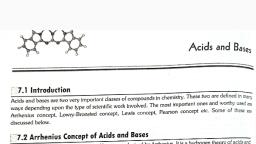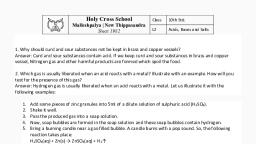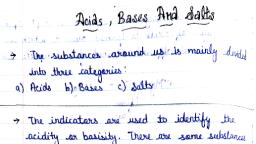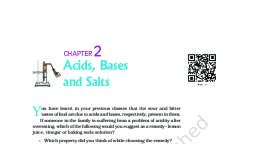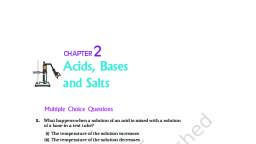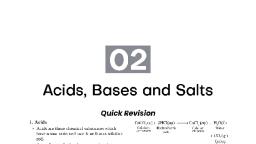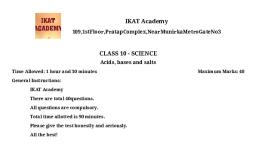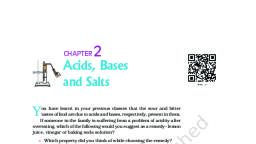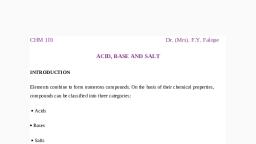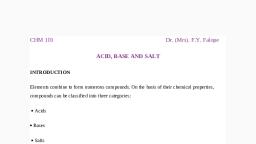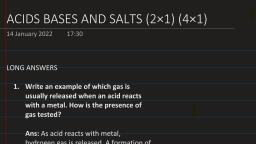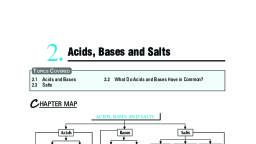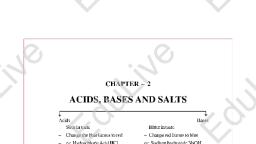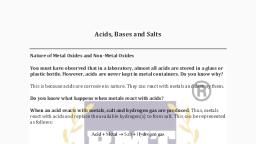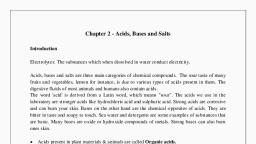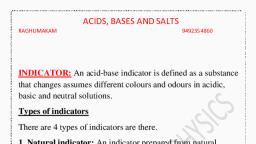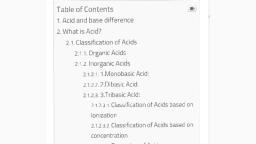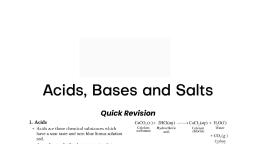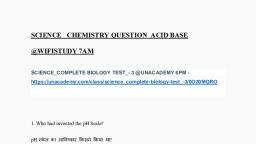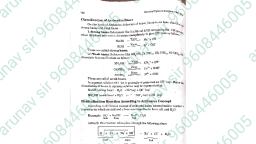Page 2 :
Indicators, Indicators is a 'Dye' that change their colour or odour when added into an acidic or, alkali solution(Alkali- a water soluble Base). Basically tell us whether a substance is, acidic or basic., There are basically 3 types of Indicators:, , Natural Indicators: These indicators are found in nature in the plants, eg:- Litmus Paper, Turmeric, , Synthetic Indicators: The indicators which are synthesised in the laboratory or, industry are known as synthetic indicators. eg:- phenolphthalein and methyl, orange, , Olfactory Indicators: Substances whose odour (smell) change in acidic or basic, medium eg:- vanilla, onion, clove, , Kuch Kaam Ki Baat (K3B) :, q. What is universal indicator ?, Acid base indicator is called universal indicator., It is a pH indicator made of C solution of several compounds that exhibit, several smooth colour changes over a wide range pH value, It indicate the acidity or alkalinity of solutions., , A. ACIDS, Chemical substances which turns blue litmus to red. And is having sour, taste (Ex- raw mango, raw grapes, lemon, orange, and tamarind (imli),, etc.), , Organic Acids and Mineral Acids, ORGANIC ACIDS(Weak Acids), The acids present in plant materials and animals are called organic, acids., Some organic acids Acetic acid, lactic acid, citric acid, Tartaric acid, oxalic Acid and formic acid.
Page 3 :
ORGANIC ACID, Acetic acid, Citric acid, lactic acid, Tartaric acid, Oxalic acid, Formic acid(Methanoic acid), , --->, --->, --->, --->, --->, --->, , NATURAL ACID, Vinegar (Sirka), Citrus Fruit, Sour milk or curd, Tamarind and grapes, Tomato, Ant sting and Needle leaf sting, , MINERAL ACIDS (Strong acids), The acids prepared from the minerals of the earth. These are man made, acids., Common acids- Hydrochloric acid, sulphuric acid, Nitric acids and carbonic, acids. ( weak acid), , Concentrated and Dilute Acids, ORGANIC ACIDS(Weak Acids), A concentrated acid which contains the minimum possible amount of water, in it. " concentration of acid is decreased by adding more water', A dilute acid is one which contains much more of water in it., When concentrated acid is added to water then dilute acid is formed., , Kuch Kaam Ki Baat (K3B) :, While diluting an acid, it is recommended that the acids should be added, to water and not water to the acid., The process of mixing conc. acid with water is highly exothermic process, (Heat producing)., So when a conc. acid and water are mixed together a large amount of, (Heat) is evolved., This heat changes some of the water to steam explosively which can splash, the acid on our face or clothes and cause acid burns., Even glass container may break due to excessive heating
Page 4 :
Chemical Properties of Acids, Reaction with Metals, Metal + dilute acid ⟶ Salt + hydrogen gas, Eg:- Zn + H2SO4⟶ ZnSO4 + H2O, Most of the acids react with metal to form salt and evolve H2 gas., As we see that acids react with the metal to form poisonous salt therefore, we do not keep curd or sour eatables in brass or copper metals, , NCERT ACTIVITY, (AASAN BHASHA MEI), , 1 Reaction of zinc granules with dilute sulphuric acid and testing hydrogen gas by burning, , Chalo Ab Ise AASAN BHASHA MEI Samajhte hai :, , Take a few pieces of zinc granules in a boiling tube and add about 5 mL of, dilute sulphuric acid to it ., We will observe the formation of gas bubbles on the surface of zinc granules., Pass the gas being formed through the soap solution taken in a trough (by, means of a glass delivery tube). Gas filled bubbles are formed in the soap, solution which rise into the air., Bring a burning candle near a gas-filled soap bubble. The gas present in soap, bubble burns with a ‘pop’ sound (making a little explosion)., Only hydrogen gas burns making a ‘pop’ sound. This shows that hydrogen gas, is evolved in the reaction of dilute sulphuric acid with zinc metal (taken in the, form of zinc granules)
Page 5 :
Reaction with Metals Carbonate and Metal Hydrogencarbonate, , Metal carbonate/ metal hydrogen carbonate + acid⟶ salt + CO2 + H2O, eg: - CaCO3 + 2HCl ⟶ CaCl2 + H2O+ CO2, eg:- Na2CO3(s) + 2HCl(aq) -> 2naCl(aq) + CO2(g) + H2O(l), The CO2 (Carbon dioxide) gas is formed with Brisk effervescence., , Kuch Kaam Ki Baat (K3B) :, , TEST for CO2 gas, , When CO2 gas is passed through lime water (Ca(OH)2), it turns milky due to the, formation of the white precipitate of CaCO3., i.e. Ca(OH)2 + CO2, , ⟶ CaCO3 + H2O, , But if CO2 is passed in excess, milkiness disappeared due to the formation of, Ca(HCO3)2 which is soluble in water, i.e. CaCO3 + H2O, , ⟶ Ca(HCO3)2, , NCERT ACTIVITY, (AASAN BHASHA MEI), TEST for CO2 gas, , Chalo Ab Ise AASAN BHASHA MEI Samajhte hai :, Take a boiling tube and put about 0.5 g of sodium carbonate in it., Add about 2 mL of dilute hydrochloric acid in the boiling tube (through a, thistle funnel), We will observe that brisk effervescence of a gas is produced., Pass the gas through lime water. The lime water turns milky (showing that it is, carbon dioxide gas)., Keep on passing carbon dioxide gas through milky lime water for some more, time. The lime water becomes clear again., This shows that the white precipitate of calcium carbonate dissolves on passing, excess of carbon dioxide gas. We can repeat this experiment by using sodium, hydrogencarbonate in place of sodium carbonate. Again we will get carbon, dioxide gas which will turn lime water milky. On passing excess of carbon dioxide,, the milky lime water will become clear again.
Page 6 :
Kuch Kaam Ki Baat (K3B) :, If someone is suffering from the problem of acidity after over eating then it, is recommended to take baking soda as remedy., The is because baking soda ie sodium hydrogen carbonate which react with, excess hydrochloric acid in the stomach and neutralises it. This give relief to the, person suffering From acidity., NaHCO3(aq) + HCl(aq) -> NaCl(s) + CO2(g) + H2O(l), Sodium Hydrogen, carbonate, , Hydrochloric, , Sodium chloride, , acid, , Carbon dioxide gas is used to extinguish fire., It is because carbon dioxide does not support combustion, when sprayed on, burning object it stops the supply of oxygen and extinguishable fire., , L.P. A solution reacts with crushed eggs shells to give a gas that turns lime turns milky., The solution contains?, A. NaCl, B. HCl, C.KCl, D.Lid, Solution :The egg shell are made up of calcium carbonate and gas which turns lime, water milky is carbon dioxide. Carbon dioxide gas can be formed by the action of an, acid solution calcium carbonate. So, the solution contain HCl. (Option B), , Reaction with Metals Oxides, , metal oxide + acid⟶ salt + water, Eg: CuO + 2HCl ⟶ CuCl2 + H2O, This reaction shows basic nature of metal oxides., , Kuch Kaam Ki Baat (K B) :, Acids are never stored in metal container, Acids have corrosive nature, so they gradually corrode the metal container., So, Acid should always store in container made up of glass and ceramics, because they are not attacked by acids, , What do all Acids have in common?, A common thing in all the acids is that they produce hydrogen ions [H+ ions], when dissolved in water., Acidic behaviour of an acid solution is due to presence of hydrogen ions in, it., Hydrochloric acid (HCl) shows acidic character because it ionises in aq., solution to produce hydrogen ions., HCL(aq) -> H+(aq) + Cl-(aq), Acetic acid (CH3COOH) shows acidic character because it ionises in aq., solution to produce hydrogen ions., CH3COOH(aq) -> Ch3COO-(aq) + H+(aq)
Page 7 :
Sulphuric acid (H2SO4) shows acidic character because it ionises in aq, solution to give hydrogen ions., 2-, , H2SO4(aq) -> 2H+(aq) + SO4 (aq), , Kuch Kaam Ki Baat (K3B) :, All acids contains hydrogen but all the hydrogen containing compounds, are not acids., Ex: Aq solution of glucose and alcohol does not show acidic behaviour because, yes it is true they contains hydrogen but their hydrogen does not separate out as, H+ ions on dissolving into water., Lets do an activity to understand it further:, , NCERT ACTIVITY, (AASAN BHASHA MEI), , Activity to investigate whether all compounds containing hydrogen are acidic., , Chalo Ab Ise AASAN BHASHA MEI Samajhte hai :, (i) Take solutions of hydrochloric acid, sulphuric acid, glucose and alcohol. All, these are hydrogen containing compounds., (ii) Fix two iron nails on a rubber cork and place the cork in a beaker.(Fig (a) on, next page), (iii) Connect the nails to the two terminals of a 6 volt battery through a switch and, a bulb., (iv) Pour some dilute hydrochloric acid solution (HCl solution) in the beaker and, switch on the current. The bulb starts glowing.(Fig a), This shows that hydrochloric acid solution taken in the beaker conducts electricity., If we repeat this experiment by taking sulphuric acid solution in the beaker, the, bulb glows again. This shows that sulphuric acid solution also conducts electricity., In fact, all the acid solutions conduct electricity., , (v) Let us now take glucose solution (C6H12O6 solution) in the beaker and switch, on the current. The bulb does not glow in this case (Fig b). This shows that glucose, solution does not conduct electricity., If we repeat this experiment by taking alcohol solution in the beaker, the bulb does, not glow again. This shows that alcohol solution also does not conduct electricity.
Page 8 :
Hence, The aqueous solution of an acid conducts electricity due to the, presence of charged particles called ions in it., Now you will be understand these points also:, Distilled water does not conduct electricity because it does not contain any, ionic compound (like acids, bases or salts) dissolved in it., Rain water, while falling to the earth through the atmosphere, dissolves an, acidic gas carbon dioxide from the air and forms carbonic acid (H2CO3)., Carbonic acid provides hydrogen ions, H+(aq), and carbonate ions, 2CO3 �, (aq), to rain water. So, due to the presence of carbonic acid (which provides, ions to rain water), the rain water conducts electricity., , Kuch Kaam Ki Baat (K3B) :, The acidic behaviour of acids is due to the presence of hydrogen ions, H+(aq), ions, in them. The acids produce hydrogen ions only in the presence of water., , So, in the absence of water, a substance will not form hydrogen ions and, hence will not show its acidic behaviour., , NCERT ACTIVITY, (AASAN BHASHA MEI), , Experiment to show that acids do not show acidic behaviour without water.
Page 9 :
Chalo Ab Ise AASAN BHASHA MEI Samajhte hai :, Take about 1 g Solid sodium chloride (NaCl) in clean and dry boiling tube and add, conc. sulphuric acid to it carefully and fit the rubber con over glass tube., Conc. sulphuric acid reacts with Sodium chloride to form hydrogen chloride gas., The hydrogen chloride gas starts coming out of the open enclave., Hold a 'dry' blue litmus paper in HCl gas. So there is no change in the colour of dry, blue litmus paper. This show shows that HCl gas does not behave as an acid to, the absence of water., We now hold a 'moist' blue litmus paper in HCl gas, Now we will see the 'moist', blue litmus paper to red. This shows that HCl gas show acidic behaviour in the, presence of water., Conclusion: HCl gas does not shout acidic behaviour in absence of water but it, shows acidic behaviour in presence of water., , B. BASES, Chemical substances which turns red litmus to blue. And is having bitter, taste and soapy to touch., Some common water soluble bases:, Sodium Hydroxide (NaOH), Potassium Hydroxide (KOH), Calcium Hydroxide (CaOH2), Magnesium Hydroxide(MgOH2), , What do all Bases have in common?, A base is the substance which dissolve in water to produce hydroxide ions, (OH- ions) in solution., EXAMPLES:, Sodium hydroxide(NaOH) is a base because it dissolve in water to produce, OH- ions., NaOH -> Na+(aq) + OH-(aq), Potassium hydroxide is a base which dissolve in water to give OH- ions., KOH -> K+(aq) + OH-(aq), This presence of OH- ions indicated that it has basic or alkaline properties.
Page 10 :
Strong base and Weak Base, STRONG BASE, A base which completely ionises in water and thus produce a large amount, of (OH- ions) is called Strong base., Sodium hydroxide (NaOH) and potassium hydroxide (KOH) are strong base, because they completely ionise on dissolving in water to produce a large, amount of OH- ions., , WEAK BASE, A base which is partially ionised in water and hue produce o small amount, of (OH- ions)., Ammonium hydroxide [ NH4(OH)], calcium hydroxide Ca(OH)2, and, Magnesium hydroxide [Mg(OH)2] dissolve in water to produce a small, amount Of OH- ions., , Physical Properties of Bases, Bitter in taste, Soapy to touch, Conduct electricity in solution, Turns red litmus to red, , Chemical Properties of Bases, Reaction with Metals, metal + base⟶ salt + hydrogen, Eg:- Zn + 2NaOH ⟶ Na2ZnO2 + H2, This is the reason why Bases को भी metal container मैं नहीं रखते, , Reaction with Non-Metal Oxide, Base + non-metallic oxide⟶ salt+ water, Eg:- CO2 + Ca(OH)2 ⟶ CaCO3 + H2O, This reaction proves that non metallic oxides are acidic in nature
Page 11 :
C. ACID+BASE, Acids react with bases to produce salt and water., Acid + Base ⟶ Salt + Water, In this reaction, An acid neutralises a base; that is acid nullifies or reduces the, effect of a base or vice versa the reaction is called a neutralisation reaction., Eg:- HCl + NaOH, , ⟶ NaCl + H2O, Sodium chloride(Salt), , 2NaOH(aq) + H2SO4(aq) -> Na2SO4(aq) + 2H2O(l), Sodium Sulphate(Salt), , pH Scale, Scale to measure the strength of acid or base, It has values ranging from 0( very acidic) to 14 (very basic/alkaline)., pH - The number which indicates the acidic or basic nature of the solution., , Kuch Kaam Ki Baat (K3B) :, , IMPORTANCE OF pH IN EVERYDAY LIFE, , Plants and animals are pH-sensitive:, Living organisms can survive only in a narrow range of pH change, our Body, works normally within a pH range of 7.0 to 7.8, When pH of rainwater goes below 5.6 it is called, , acidic rain. When acid rain, , flows into rivers it lowers the pH of the river water and make the survival of, Aquatic life difficult
Page 12 :
pH of the soil:, Every type of client requires a specific pH range for healthy growth. Therefore, the nature of the soil is known first by testing its pH and then a particular crop is, grown in it. It is suitable for selecting the fertiliser for a particular crop by, knowing the pH of the soil., , pH in our digestive system:, HCl is present in our stomach which helps in the digestion of food. As during in, indigestion in the stomach produces too much acid, it causes pain and irritation., To correct the distributed pH range, milk(a mild base) is used as a medicine, also, called Antacid as it reduces the effect of acid or acidity., , pH change leads to tooth decay:, Tooth enamel is made up of calcium phosphate and is the hardest substance in, the body. If the pH inside the mouth decreases below 5.5 acidic the delay of the, tooth in enamel begins., Bacteria present in the mouth degrades the sugar and leftover food particles, and produce acids that remain in the mouth after eating. The best way To, prevent this is to clean the mouth after eating food. To cure tooth decay, toothpaste (basic) are used which neutralise the excess acid., , Self-defence Plant and animals through chemical welfare:, When insects like honeybee, ant etc bite, they eject an acid into the skin,, that causes pain and irritation. If a mild base like baking soda is applied the, affected area, it gives relief., , pH in plants:, Stinging hair of nettle leaves injects methanoic acid in the skin which causes, burning pain., It is cured by rubbing the affected area with the leaves of the dock plant, which, often grows beside the nettle plant., , Kuch Kaam Ki Baat (K3B) :, Dilution: Mixing an acid or base with water results in a decrease in the, concentration of Ions per unit volume solution and acid at the base is said, to be diluted.
Page 13 :
Note: The acid must always be added slowly to water with constant, steering because the process is highly exothermic. If water is added to a, concentrated acid, The heat generated may cause the mixture to splash, out and cause burns, the glass may also break due to excessive local, heating., , D. SALTS, Found by neutralisation reaction. [Acid + Base ⟶ Salt + Water], Salt of strong acid and a weak base is acidic with pH value less than 7 salts so, strong base and weak acid are basic in nature with pH value more than 7., , Physical Properties of Salts, Salts are mostly solids, they have mostly high melting and boiling point, Salts are usually soluble in water and conduct electricity., Salts conduct electricity due to presence of ions in them., Salts are ionic compounds, every salts consist positively charge ion (Cation), and negatively charge ion (Anion)., , Family of Salts: The salts having same positive ions are said to belong to a, family of salts. Ex- Sodium Chloride(NaCl) and Sodium Sulphate(Na2SO4), belong to same family of salts called sodium salts(because they both, contain the same positively charged ions, sodium ions Na+), , Common salt [ Sodium chloride, NaCl], This is the salt we use in food(Tata namak desh ka namak!). Sea water contains, many salts dissolved in it. Sodium chloride is separated from the salt deposits of, solids. Deposits of solid salt are also found in several parts of the world. These, large crystals are often brown due to impurities this is called rock salt., The common salt thus obtained is an important raw material for various materials, of daily use such as Sodium Hydroxide, baking soda,washing soda, bleaching, powder and many more.
Page 14 :
Kuch Kaam Ki Baat (K3B) :, Chlor-Alkali Process [Preparation of above materials], When electricity is passed through an aqueous solution of sodium chloride, (called brine)., 2NaCl(aq) + 2H2O(l), , ⟶ 2NaOH(aq) + Cl2 (g) + H2(g), , Chlorine gas is given off at the Anode and hydrogen gas at the cathode. Sodium, hydroxide solution is formed near the cathode., , Bleaching powder[ calcium oxychloride, CaOCl2], Preparation: By passing chlorine gas over slaked lime, Ca(OH)2 + Cl2 ⟶ CaOCl2 + H2O, Uses:, For bleaching cotton textile, For Disinfecting drinking water, As an oxidising agent in the chemical industry, Manufacturing chloroform, , Baking SOda [Sodium hydrogen carbonate NAHCO3], Preparation: On reacting cold concentrated calcium chloride (brine) Solution, with Ammonia and carbon dioxide., , Uses:, For making baking powder, which is a mixture of baking soda and a mild, edible acid such as tartaric acid. When baking in the reaction takes place:NaHCO3 + H+, , ⟶ CO2 + H2O + sodium salt of acid, , Ingredient in antacids, Uses in Soda-acid fire extinguisher
Page 16 :
Ans- D, , Ans- D, , Ans- B, , Ans- A
Page 17 :
Ans- C, , Ans- A, , Ans- B, , Ans- B
Page 18 :
A is true but R is false, , Ans- B
Page 19 :
Ans- C, , Ans- C, , Ans- A, , Ans- A, , Ans- B
Page 20 :
Ans- B, , Ans- B
Page 21 :
PREVIOUS YEAR QUESTIONS, (Converted into MCQ format)
Page 26 :
PYQ MCQ ANSWERS:, 1. b, 2. a, 3. d, 4. d, 5. a, 6. d, 7. a, 8. a, 9., 10., 11. c, 12. c, 13. a, 14., 15. b, 16., 17., 18., 19., 20., 21. b, 22. c, 23, 24 a, 25, 26. d, 27, 28. I- a, II- ,III-a
